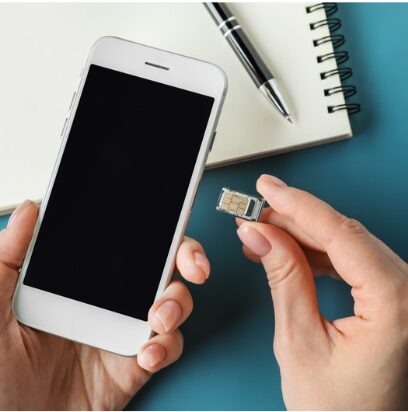Introduction to SIM Card Tracking
SIM card tracking is a technology that allows you to monitor and locate a device or individual by using the unique identifier associated with their SIM card. This powerful tool has a wide range of applications, from asset tracking and fleet management to personal safety and law enforcement.

In this comprehensive guide, we’ll dive deep into the world of SIM card tracking. We’ll explore how this technology works, discuss the key considerations for choosing the right SIM card, and walk you through the process on how to configure a SIM card for tracking purposes. Also, we’ll cover the legal and privacy concerns about SIM card tracking. We’ll also highlight some real uses of this technology.
Understanding SIM Card Technology
At the core of SIM card tracking lies the SIM (Subscriber Identity Module) card itself. This small, removable chip plays a crucial role in identifying a user’s mobile device on a cellular network. Each SIM card possesses a unique identifier known as the IMSI (International Mobile Subscriber Identity), which enables the network to recognize and authenticate the device.
When a mobile device inserts a SIM card, it connects to the cellular network. This connection allows the device to make calls. It also lets it send text messages and access the internet. This is important. It also lets the network track the device’s location. This forms the foundation for SIM card tracking.
Choosing the Right SIM Card for Tracking
When embarking on a SIM card tracking project, selecting the right SIM card is paramount. Several key factors should guide your decision:
Network Coverage: Choose a SIM card that runs on a network with good coverage. It should cover the areas where you need to track the device. Consistent network connectivity is essential for accurate location data.
Data Plan: Assess your tracking needs. Choose a SIM card with a data plan that can support sending location data. Consider the frequency and volume of data you’ll need to transmit.
Tracking Features: Some SIM card providers offer specialized tracking features, such as real-time location updates, geofencing, and historical location data. Evaluate your needs and select a SIM card that aligns with your requirements.
Cost: SIM card tracking can involve additional costs, including activation fees, monthly service charges, and data usage fees. Compare pricing across different providers to find the most cost-effective solution.
Configuring SIM Card Settings
With the appropriate SIM card in hand, the next step is to configure it for tracking purposes. This process typically involves the following steps:
- Activate the SIM Card: Follow the provider’s instructions to activate the card and ensure it’s ready for use.
- Enable Location Services: Check that the device’s SIM card has enabled its location services. This allows the device to send its location to the tracking system.
- Configure Tracking Software: Install and set up the tracking software or app that will monitor the device’s location. This may involve creating user accounts, configuring tracking parameters, and integrating the SIM card with the software.
- Test the Tracking System: Conduct thorough tests to confirm that the SIM card and tracking system are functioning correctly. Verify the accuracy of location data, ensure alerts and notifications are working as expected, and troubleshoot any issues that arise.
Setting Up Tracking Software
You must set up the SIM card. Also, you need to configure the tracking app. This is crucial for monitoring the device’s location. This process may involve the following steps:
- Choose a Tracking Solution: Research and compare many tracking software and apps. Select one that best fits your needs features, usability, and cost.
- Create User Accounts: Set up accounts for people who will access the tracking system. Configure their permissions and access levels as needed.
- Configure Tracking Parameters: Tailor the tracking system to your needs. For example, set up geofences, schedule location updates, and configure alerts.
- Integrate the SIM Card: Connect the SIM card to the tracking software. This ensures that the device sends and displays its location data.
- Test and Troubleshoot: Thoroughly test the tracking system to confirm it’s working as expected, and address any issues that arise.
Testing and Troubleshooting
Once the SIM card is configured and the tracking software is set up, it’s essential to rigorously test the system to ensure its proper functioning. This process may include:
- Verify Location Accuracy: Test the accuracy of the location data by comparing it to known locations or alternative tracking methods.
- Check Connectivity: Confirm that the device with the SIM card maintains a stable connection to the cellular network and that the tracking software is receiving location data as expected.
- Test Alerts and Notifications: Verify that the tracking system generates the appropriate alerts and notifications based on the configured parameters.
- Troubleshoot Issues: If any issues or discrepancies arise, collaborate with your SIM card provider and tracking software vendor to troubleshoot and resolve them.
Best Practices for SIM Card Tracking
To ensure the effective and responsible use of SIM card tracking, adhere to these best practices:
- Obtain Consent: If tracking individuals, ensure you have their explicit consent and that they understand how their location data will be used.
- Comply with Regulations: Familiarize yourself with the relevant laws and regulations governing the use of location tracking technologies in your jurisdiction, and ensure your practices are compliant.
- Protect Data Privacy: Implement robust security measures to safeguard the location data collected through SIM card tracking, and only share it with authorized individuals or entities.
- Regularly Review and Update: Periodically review your tracking practices and update your policies and procedures as needed to maintain effectiveness and compliance.
- Train Users: Provide comprehensive training and guidance to individuals who will be using the SIM card tracking system, ensuring they understand how to use it properly and responsibly.
Legal Considerations and Privacy Concerns
The use of SIM card tracking technology raises significant legal and privacy concerns that must be carefully navigated. Many jurisdictions have laws and regulations governing the collection and use of location data, and non-compliance can result in severe penalties.
Also, there are ethical issues. They concern the privacy of people whose location data is being tracked. It’s crucial to ensure that people are aware of and consent to the tracking. And that we use the data ethically and responsibly.
To address these concerns, familiarize yourself with the relevant laws and regulations in your area and implement robust data privacy and security measures to protect the location data collected through SIM card tracking.
Real-World Applications of SIM Card Tracking
SIM card tracking has a wide range of real-world applications, including:
- Asset Tracking: Monitor the location of valuable assets, such as vehicles, equipment, or inventory, to enhance asset management and security.
- Fleet Management: Track the location and movement of a fleet of vehicles to optimize routing, improve driver safety, and boost overall fleet efficiency.
- Personal Safety: Monitor the location of individuals, such as children or elderly family members, to ensure their safety and well-being.
- Law Enforcement: Assist law enforcement agencies in tracking the location of suspects or missing persons, subject to appropriate legal and ethical considerations.
- Logistics and Supply Chain Management: Track the location of shipments and deliveries to improve supply chain visibility and efficiency.
Frequently Asked Questions
Q: Is SIM card tracking legal?A: The legality of SIM card tracking depends on the specific laws and regulations in your jurisdiction. Familiarize yourself with the relevant laws and ensure your tracking practices are compliant.
Q: How accurate is SIM card tracking?A: SIM card tracking’s accuracy can vary. It depends on factors. These include network coverage, device location, and tracking technology. SIM card tracking can provide location data. It is accurate to within a few hundred meters.
Q: Can we use SIM card tracking to track people without their consent? In most cases, doing so would invade their privacy and may be illegal. It’s crucial to get consent. And, to make sure people understand how their location data is being used.
Q: How can I protect the privacy of individuals whose location is being tracked?A: Implement robust data privacy and security measures, such as encryption, access controls, and secure data storage. Ensure that location data is only accessed by authorized individuals and used for legitimate purposes. Regularly review and update your privacy policies and practices to maintain compliance with relevant laws and regulations.
You can harness SIM card tracking by understanding its technology. This means picking the right SIM card and setting it up well. It also means following best practices and laws. This allows you to meet your tracking needs while respecting privacy.





